A nail gun or nailer is not actually a real gun for hunting, but for driving nails into wood. For safety, it must make contact with the wood and then the tip or muzzle is depressed and the trigger pulled before a nail can be fired. This sequence ensures maximum safety when using the tool.
Nail guns are very useful because they make your job as a woodworker easier and increase your productivity.
You don’t have to stay under the sun all day swinging at nails with a hammer. You just have to load the nail gun magazine with nails, place the tip at the spot you want to nail, compress it and pull the trigger.
The nail sinks into the wood in a split second, and you move on to another spot. You save your energy, you save time and you increase productivity.
When you swing at a nail using a hammer, you might miss the nail head and hit the workpiece instead, marring or damaging the surface. With a nail gun, you don’t swing and miss, you just place the tip directly on the wood, and you can drive the nail right at the spot you want it driven. So, there’s no accidental marring of the workpiece if you handle it correctly.
There’re different types of nail guns available today. They’re usually differentiated from each other by the size and length of nails they fire and the type of application they’re used for.
Some are used for framing, roofing, decking, siding, interior work and for exterior work. Some nailers drive long 3-1/2 inch nails for joining large lumber pieces like 2x4s, 2x6s and so on, while other drive shorter and thinner nails for joining thinner and more fragile materials like trim, sheathing and moldings.
Here are the 10 different types you can use for your projects and their applications.
Table of Contents
1. Framing Nail Guns
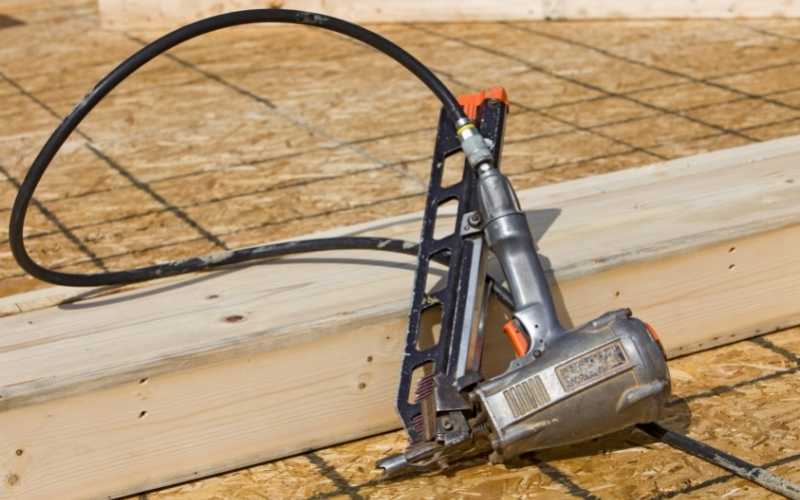
A framing nail gun is simply a tool for driving framing nails up to 3.5 inches in length into wood or similar material. These are the largest and most powerful nail guns you’ll likely find out there.
As the name implies, they are used for connecting large dimensional lumber pieces used for framing buildings. You can also use it for other woodworking projects that will require you to nail large lumber pieces like 2x4s and 2x6s such as building a deck, a fence or even building furniture pieces.
There are different types you can choose from and they’re usually categorized according to their source of power.
They include pneumatic or air-powered, fuel powered and battery powered or cordless framing nailers.
2. Brad Nailers

Brad nailers are interior nailers used for trim installation and cabinet making. They make use of fine 18 gauge nails which are very tiny and practically invisible once you’ve driven them into the wood.
18 gauge nails are very hard to drive manually using a hammer. You can either bend the nail while hammering it, miss the nail and hit the workpiece, damaging it or you can even hit and hurt your hand.
That’s why brad nailers are very important especially for home renovation projects where you have to install moldings and trim all over the house, while driving hundreds or even thousands of these tiny nails.
The tiny brads are so tiny that they’re not meant for heavy crown moldings or trim, because they lack the strength it requires. It’s best for installing small trim and lighter moldings.
Furthermore, the tiny size makes them very easy to conceal in small pieces of trim. Sometimes, you don’t even need to conceal them further once they’re fully driven into the trim.
Having the brad nailer in hand will simplify your work, making it neater, easier and faster.
3. Finish Nailers
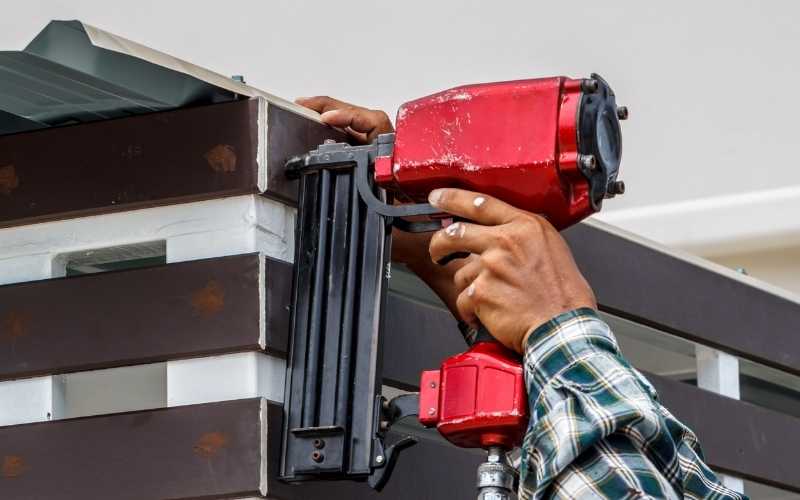
Because brad nails are so tiny, they lack enough holding power to hold heavier trim and moldings. That’s why there’re finish nailers. These make use of 15 and 16 gauge nails or wire which are thicker and stronger than the 18 gauge brad nails.
They have more holding power and withdrawal resistance and thus are better suited for installing larger trim and moldings.
The only disadvantage it has is that the finish nails leave a more visible hole when they’re fully driven into the trim, and thus require further attention to conceal the hole.
4. Siding Nailers

A siding nail gun is primarily used for siding installation. Some might argue that you can still use a framing nailer for siding installation, and that’s technically correct.
However, both nail guns are different because siding require the use of smaller nails between 1-1/2 inch to 2-1/2 inches in length. Whereas framing nails can be up to 3-1/2 inches long or even more.
Siding nailers because of the smaller nail sizes and smaller magazine are also lighter in comparison to framing nailers which have a bigger magazine that carry longer nails.
This means you’ll experience less fatigue when using the siding nailer for your project.
5. Roofing Nail Guns
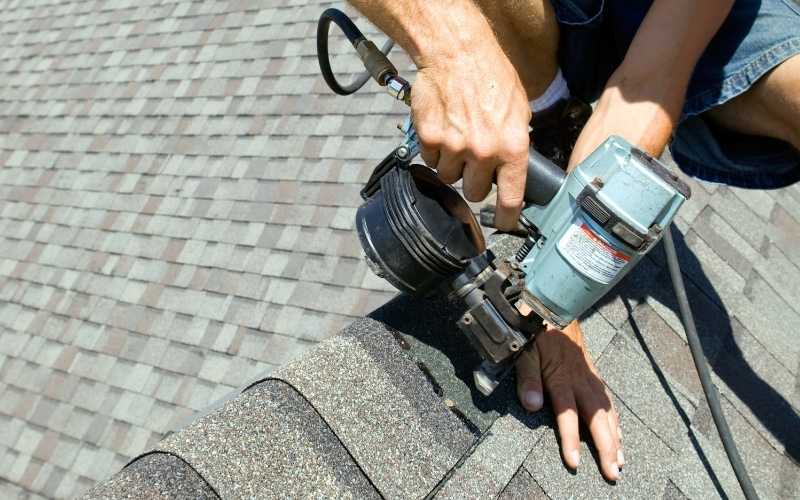
As the name implies, roofing nail guns are used for driving roofing nails from ¾ inch to 1-3/4 inches long. These are specially designed for nailing different types and sizes of shingles, vinyl material, insulation boards, fiber cement, waterproof tar paper and are even used sometimes for siding.
You can set nail depth easily and most usually come with an adjustable shingle guide to help you space shingles appropriately.
Instead of a straight magazine, they usually come with a coil magazine or canister to accommodate more nails, reducing the amount of time you have to reload the magazine.
6. Concrete and Steel Nailers
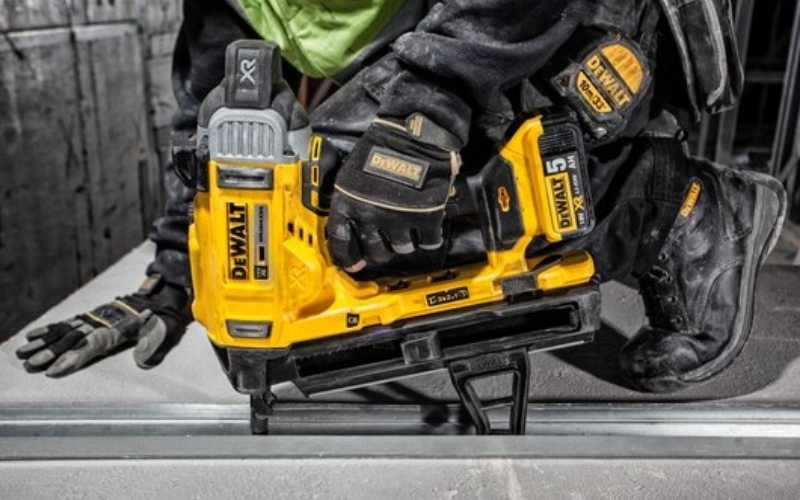
Driving fasteners into concrete and steel materials can be quite difficult by hand. That’s why there’re nailers designed specifically for this.
Concrete and steel fasteners or pins are different and have different sizes and gauge. That’s why you cannot use a typical framing nailer for concrete.
Most concrete nail guns are usually pneumatic, but presently there’re cordless electric units like the Dewalt DCN890P2 that takes the game to the next level. Allowing you to drive fasteners into steel and concrete without pneumatic power and without the use of fuel cells.
7. Pin Nailers
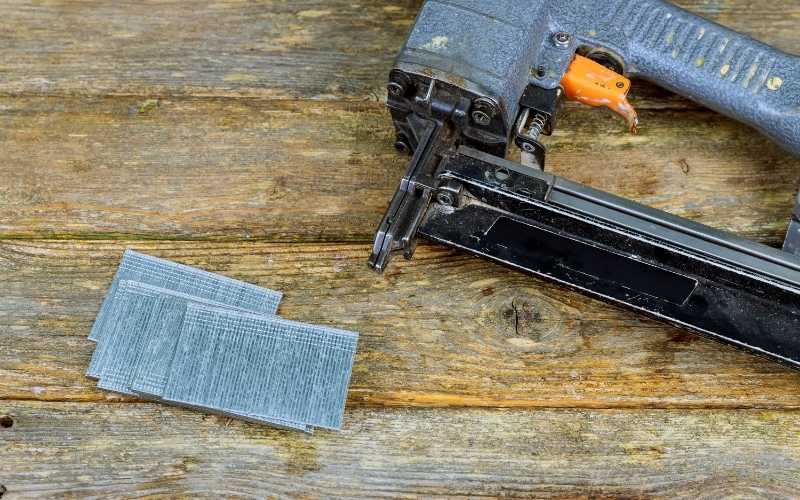
Pin nailers make use of 23 gauge nails. These nails are so tiny, they look like pins, and they don’t have flat head like other nails.
They’re often used for furniture and cabinet making, and also for installing moldings and trim, especially if a thicker nail will likely split the wood you’re working on. When driven into the wood they pretty much disappear into it without leaving any mark or hole to fill with a wood putty.
You can also use a pin nailer to hold down glued wood pieces together for added holding power. Note that these pins are very tiny and don’t have enough holding strength or withdrawal resistance, so you should only use them for light-weighing wooden pieces.
8. Palm Nail Guns
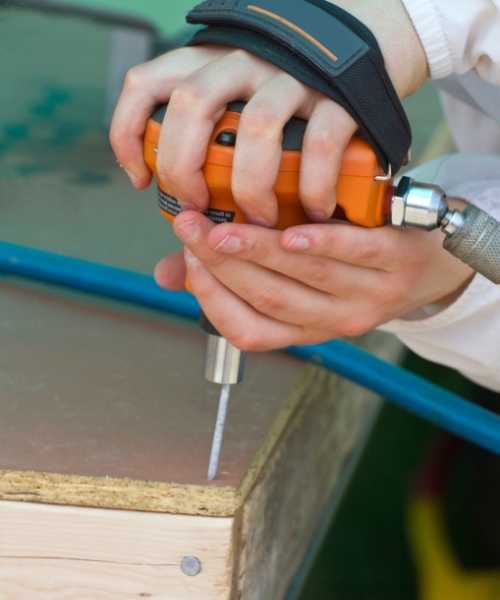
Unlike other nail guns with straight handles that can be held, palm nailer handles are kind of round and fit right into your palm.
They’re built this way so you can fit them into tight corners and drive nails where you can’t fit the other big bulky nailers.
You also don’t get any type of magazine to hold the nails with this one. You just pick one nail and drive it with the palm nailer, one at a time.
I think that’s the major drawback they have. Apart from that, they’re very useful nail guns you need for driving nails where other type of nailers can’t fit into the space.
9. Hardwood Flooring Nailer
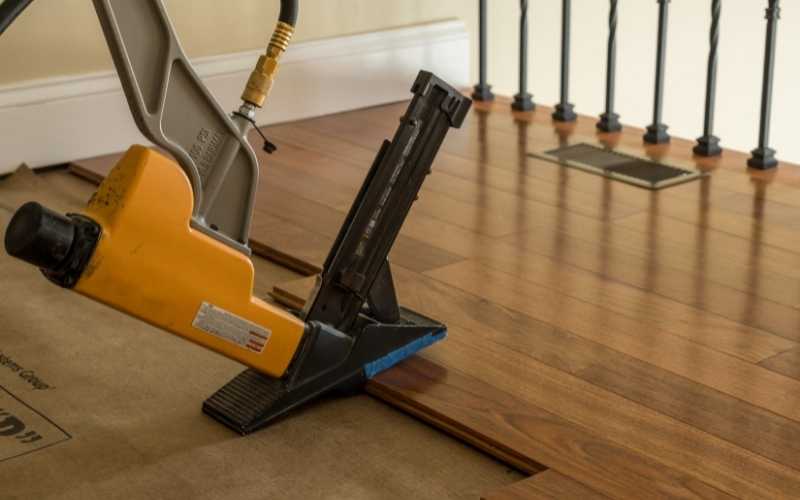
The hardwood flooring nailer doesn’t really look like the usual nail gun, but it is. It comes in two types, manual and pneumatic.
The nails used are known as cleats and don’t look like the normal ones used for other wood fastening applications, and they either have an “L” head or a “T” head.
When buying a flooring nailer, you make sure to check the type of nail it uses, so you can buy the same type of nails or cleat to go with it.
Unlike other nail guns that don’t require any manual action on your part to insert nails, both the manual and pneumatic flooring nailers require some form of force from you.
You have to use a mallet to heat the drive head to insert a cleat in both manual and pneumatic variations.
However, while you provide all the driving force when using a manual type, the pneumatic units provide additional force through the connected compressed air to help drive the cleats into the floor.
10. Staple Nail Gun
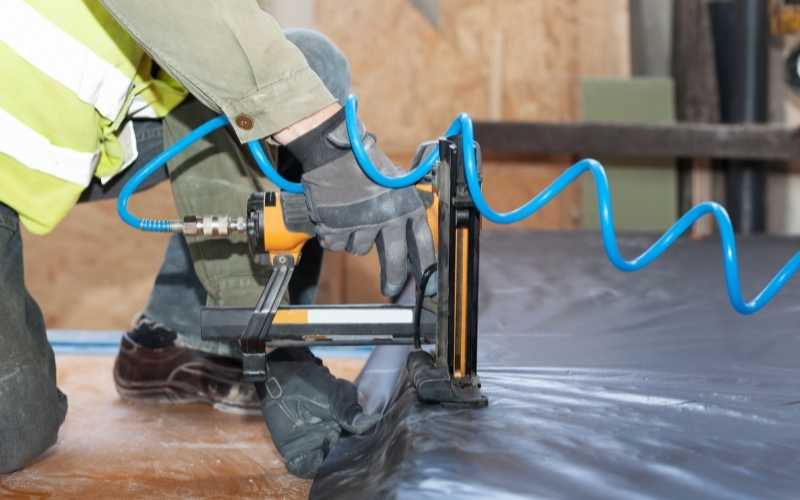
Framing nails, brad nails and pins can’t hold down fragile materials like carpet, fabric, thin plywood, sheathing and so on.
These materials are so thin and light that they’ll pull right off if you use these type of fasteners. What you need to hold them securely is a staple gun that drives staples. They’re ideal for use when the material is too fragile to withstand the force of other nail guns.
Power Source
Each of the different types of nail guns are usually classified by their power source. They’re classified into pneumatic or air powered, fuel powered, corded electric and cordless electric.
Pneumatic nail guns are powered using compressed air from an air compressor. You have to buy an air compressor, a hose and fittings to connect the tool to the compressor machine.
Air powered or pneumatic nail guns are often lighter in comparison to cordless models and often more powerful. Their major drawback is that you have to drag an air hose with you wherever you want to use them.
Fuel powered nailers like the Paslode XP shown here make use of a combination of a fuel cell and a battery for power, just like a miniature engine. The sudden combustion and expansion of the fuel produces the power that drives the fastener into the wood.
They’re not as popular as they used to be due to advancement in battery powered cordless models, but they favorite to many craftsmen, because they’re often lighter compared to battery-only models.
You also have to replace the fuel cells inside periodically depending on how often you use it, which will add to the cost of owning the tool.
powered units.
Cordless or battery powered nail guns make use of gas springs and batteries. The nail driving force is generated using a gas spring usually assembled together with the nail gun. With this innovation, you no longer need a fuel cell to run your nailer. All you need is a suitable charged battery.
These are quite heavy because of the different components making up the nail gun such as the gas spring, the battery and the brushless motor assembled together.
On the up side however, they’re very portable, requiring no cords and pneumatic hoses to operate. Setup time is also minimal. All you need is to load the magazine with nails, install the battery and you’re good to go. Cost of getting one of these is a bit high, but when you factor in the price of getting a pneumatic nailer, the hoses and the air compressor unit, you realize you’re actually getting a better deal with the battery-powered unit.

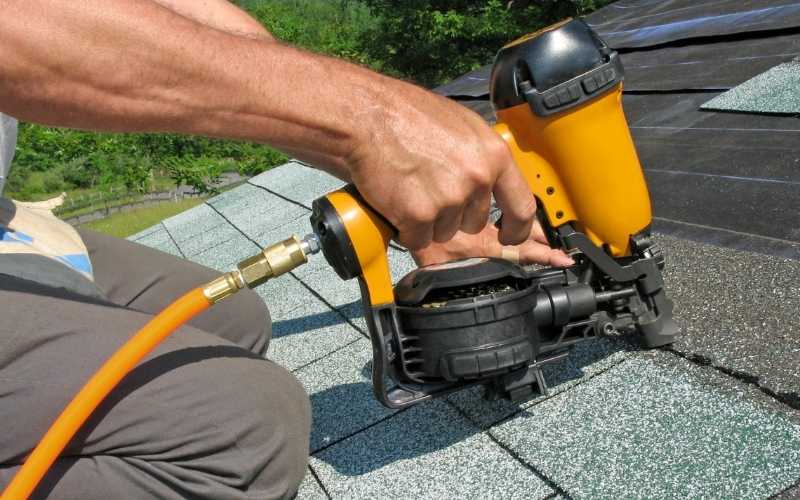
Great information! Thank you for posting details about the different type nail guns available as well as their different power sources. Your detailed descriptions helped tremendously. I plan to buy my father a nail gun but did not know much about them.
Would also like to know which nail guns can use a variety of fasteners – or do they only take one type?
Thanks again!
Great information, very helpful to understand the deference and applications of each kind. Thanks for posting.
Glad you found it helpful.
I’m building a pergola and I have 4 x 4 inch frames, and I was wondering what nail gun would be best for the job. As it’s going to be a permanent fixture and I’d like the job done without wory of high wind damage
For the posts, since they’re so wide, you can drill through them and use suitable long bolts to join them with the bearers or beams. As for the rafters, you can always use a framing nailer to fasten (to-nail) them on top of the bearers.